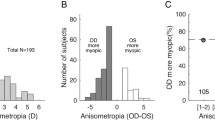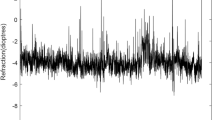Abstract
The vergence position of the eyes is determined by the near fixation-accommodationmiosis synkinesis and the fusion mechanism. The contribution of both systems was analysed in 30 normal subjects and 16 subjects with abnormal binocular vision. Prism fixation disparity curves were determined in three different experimental situations: the routine method according to Ogle, a method to stimulate the synkinetic convergence (Experiment I, with one fixation point as sole binocular stimulus) and a method to stimulate the fusion mechanism (Experiment II, with random dot stereograms). Experiment I produced flat curves and Experiment II steep curves. The mean diameter of the horizontal Panum area was 5 minutes of arc in Experiment I and 2∘ in Experiment II. On the basis of these findings, it was postulated that the synkinetic system operates in the absence of fixation disparity and the fusion system in the presence of fixation disparity. In Experiment II, esodisparities of 100 minutes of arc occur in a number of normal subjects.
The dividing line between normal and abnormal binocular vision therefore is blurred. Normal persons can display disparities, the order of magnitude of which is equal to that of the angle of squint in micro-strabismus.
Similar content being viewed by others
References
Barlow, H.B., Blakemore, C. & Pettigrew, J.D. The neural mechanism of binocular depth discrimination. J. Physiol. 193: 327–342 (1967).
Carter, D.B. Fixation disparity and heterophoria following prolonged wearing of prisms. Amer. J. Optom. 42: 141–152 (1965).
Crone, R.A. Diplopia. Excerpta Medica, Amsterdam & American Elsevier Publishing Cy. Inc., New York (1973).
Crone, R.A. Vrooland, J.L. & Sanjoto Hardjowijoto. Proportionakegelung der Fusion, Integralregelung der willkürlichen Konvergenz. Augenbewegungsstörungen, Ed. G. Kommerell: 323–323. J.F. Bergmann Verlag, München (1978).
Crone, R.A. Orthophorisation. Die binokulare Augenstellung nach Kestenbaumscher Operation. Klin. Mbl. Augenheilk. (to be published in 1979).
Fender, D.H. & Julesz, B. Extension of Panum's fusional area in binocularly stabilized vision. J. Opt. Soc. Amer. 57: 819–830 (1967).
Jampel, R.S. Representation of the near response on the cerebral cortex of the macaque. Amer. J. Ophthal. 48: 573–581 (1959).
Julesz, B. Binocular depth perception without familiarity cues. Science 145: 356–362 (1964).
Maddox, E.E. Discussion on heterophoria. Trans. Ophthal. Soc. U.K. 49: 31–44 (1929).
Ogle, K.N. Researches in binocular vision. W.B. Saunders Cy. Philadelphia (1950).
Ogle, K.N., Martens, T.G. & Dyer, J.A. Oculomotor imbalance in binocular vision and fixation disparity. Lea & Febiger, Philadelphia (1967).
Richards, W. Stereopsis and stereoblindness. Exp. Brain Res. 10: 380–388 (1970).
Schubert, G. Grundlagen der beidäugigen motorischen Koordination. Pflügers Arch. ges. Physiol. 247: 279–291 (1943).
Author information
Authors and Affiliations
Rights and permissions
About this article
Cite this article
Crone, R.A., Hardjowijoto, S. What is normal binocular vision?. Doc Ophthalmol 47, 163–199 (1979). https://doi.org/10.1007/BF00145374
Issue Date:
DOI: https://doi.org/10.1007/BF00145374




